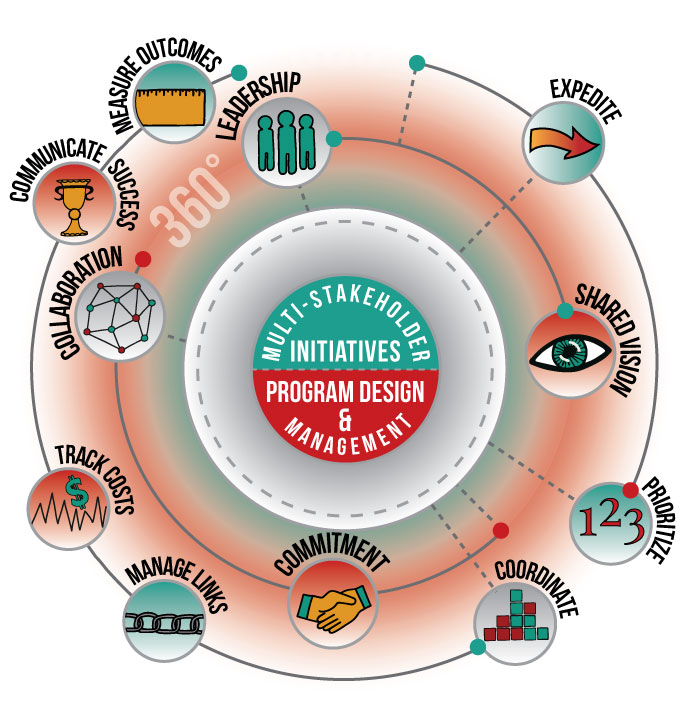HIT Perspectives – December 2019
Five Key Ingredients for Successful Multistakeholder Initiatives

By Tony Schueth, Editor in Chief

By Tony Schueth, Editor in Chief
There is no “I” in team, and not just in sports. The team approach is nearly ubiquitous in our work lives. Generally, we think of “teams” within the confines of the companies for whom we work. The health information technology (health IT) industry has expanded the idea of teams to include individuals outside the walls of their independent organizations and many times from organizations normally considered competitors. These types of initiatives aim to address widely felt industry challenges and regulatory imperatives through access to a broader group of experts and perspectives.
In fact, multistakeholder initiatives are currently under way to address various issues with standards and technology. Several examples come to mind. The CARIN Alliance is working to help consumers understand their out-of-pocket prescription costs with the consumer-facing, real-time pharmacy benefit check. The HL7 Da Vinci Project, a collaboration of payers, providers and health IT technical experts, is working to leverage HL7 Fast Healthcare Interoperability Resources in support of value-based care data exchange. Da Vinci Implementation Guides focus on topics like helping payers and providers automate collection of quality data used in Healthcare Effectiveness Data and Information Set from the provider electronic health record (EHR) and improve a payer’s ability to share details about patients’ benefits to the provider. The CommonWell Alliance is one of several groups addressing the need for a unique patient identifier.

Point-of-Care Partners (POCP) is currently the program management organization of Da Vinci and is deeply involved in CARIN. Our firsthand experience with building and managing multistakeholder initiatives started back in 2007. A coalition of employers, health plans, pharmacy benefit managers (PBMs) and industry leaders formally committed to working together as the Southeastern Michigan ePrescribing Initiative or SEMI. Over the span of seven years, SEMI delivered on its mission to improve patient safety and reduce prescription drug costs by encouraging the adoption and use of health IT in seven counties comprising nearly half of Michigan’s population of nearly 10 million. Through SEMI’s efforts, prescribing behavior has changed, patients’ lives were saved and an estimated $130 million in reduced costs were achieved.
The challenges facing SEMI are not dissimilar to those facing today’s multistakeholder coalitions. As a matter of fact, we’ve applied what we learned from our work on SEMI to the current initiatives we program manage. The drivers of today’s coalitions may be different from those that created SEMI; however, there are some similarities and critical success factors. With that, we offer the following six key ingredients for success.
1. Champion for the cause. Successful coalitions must have a champion at the top. A good champion is passionate about the cause and a strong advocate for the changes that will ensue. In addition to driving the coalition and its work forward, these qualities are essential to weather the bumps in the road that are sure to arise along the way. Successful coalitions develop change and improvement momentum by building around champions who have the standing in the industry and commitment to the cause. This in turn will help bring others on board and drive to success. In the case of SEMI, General Motors initially fulfilled that role and subsequently helped maintain the program’s momentum by providing peer-to-peer leadership, hosting steering committee meetings and, by extension, establishing a level of accountability that would have otherwise been unattainable.
2. Professional program management team. Most coalition members are volunteers who donate personal time or whose time is “donated” by their employers to participate. That is why a professional program management team with relevant skills and a deep understanding of the pain points and perspectives of various stakeholders is needed. Volunteers, frankly, do not have the bandwidth needed to manage the project on a day-to-day basis or with third-party objectivity. The value of program managers is illustrated by the following activities. Program managers can provide the resources and accountability to keep the project on track and on budget by such activities as:
• Providing consistent and accurate communications to the coalition members
• Organizing committee meetings and providing consistent monitoring of milestones and progress
• Gathering and analyzing project and budget data
• Providing neutral evaluation and measurement, and suggesting as-needed midcourse adjustments
• Tracking against steering committee-determined objectives
Program managers also need subject matter expertise. Otherwise, the coalition leadership is apt to establish unrealistic timelines, flawed plans for collaboration and unrepresentative pilot projects. There needs to be an informed balance between strategy and operations to keep the program on target and prepared for the ever-changing health care environment.
3. Coalition membership. Coalitions must have stakeholder members representing the range of views and business interests. Unfortunately, many multistakeholder initiatives fall short of goals and objectives because the right people aren’t consistently in the room or have a say in decision making. Mediocre or unsuccessful coalitions tend to exclude key stakeholders and end up talking to themselves.
In the case of SEMI, the coalition membership represented all key stakeholders impacted by the adoption and use of health IT, even in the early days of electronic prescribing (ePrescribing). The health plans held the contracts with the physicians; the PBMs represented the claims processing perspective; and employers were paying for the benefit and represented the interests of member lives (i.e., the automakers’ employees and families).
Similarly, the founding members of Da Vinci realized it was critical to have national leaders who had both the backing of their organizations and the emotional intelligence to bring the project to fruition. Having cross-functional representation from providers, payers, EHRs and their vendor partners at the table to agree to the initial use cases has been critical to the project’s success thus far.
4. Clear goals and objectives. This is the meat of any coalition’s work. What is the group trying to accomplish and how can that be carried out? How will success be measured? These must be clearly articulated, communicated and agreed to by the group. Progress needs to be monitored. Further, coalition members representing competing organizations must set aside those business relationships to work toward a common goal.
5. Know when to call it quits. There are many reasons why coalitions continue, even though it is clear they are stuck in neutral, their issue has been overtaken by events or they have accomplished what they wanted. It is heartbreaking to see groups stumble along, even though attrition among the ranks has accelerated and the group’s below critical mass. Leadership needs to know when to bite the bullet and call it quits, even if that may not be popular with some of the group’s more powerful industry leaders. As the song goes, you need to know when to hold ‘em and know when to fold ‘em. •
POCP would be happy to provide more insights on critical success factors for industry coalitions. Let us put our expertise to work for you. Visit our multistakeholder page for additional insights or drop me a line: tonys@pocp.com.
In this Issue: